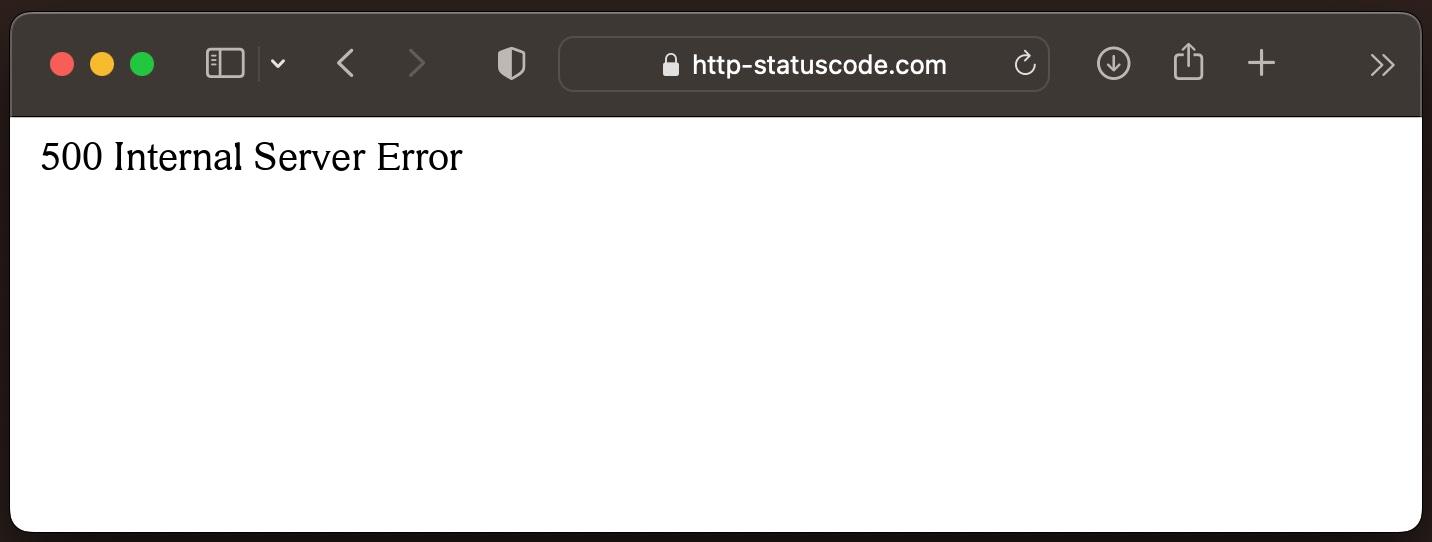500
Internal Server Error
Spiegazione generale del codice di stato 500
Questo blocco di testo è purtroppo disponibile solo in inglese.
The HTTP 500 Internal Server Error status code occurs when the server has a problem and is unable to process the user's request. This can have various reasons, such as technical problems, overloading of the server or problems with the software that runs the server.
Specifica del codice di stato HTTP 500
Fonte / Citazione da: Il codice di stato HTTP 500 Internal Server Error è specificato dalla sezione 6.6.1 di RFC7231.
Protocollo HTTP
Come lanciare un codice di stato 500 con PHP?
Per lanciare il codice di stato HTTP 500 su una pagina web, si può usare la funzione PHP http_response_code. La sintassi è la seguente: http_response_code(500) (PHP 5 >= 5.4.0, PHP 7, PHP 8)
Test del codice di stato HTTP 500
Per poter visualizzare il codice di stato HTTP (in questo caso 500 Internal Server Error) e altre informazioni sul lato client, è necessario aprire la console di sviluppo con F12. Quindi navigare nella scheda "Rete". Ora la pagina può essere aperta, il sito web (ad esempio index.php) dovrebbe essere visibile nella scheda Rete. Questo deve essere selezionato e poi deve essere selezionata la sezione Herder. L'utente vedrà quindi il seguente risultato:

URL: https://http-statuscode.com/errorCodeExample.php?code=500
Stato: 500 Internal Server Error
Quelle: Network
Indirizzo IP: XX.XX.XX.XX

Come posso risolvere il problema del codice di stato 500?
Per risolvere l'errore HTTP 500 Internal Server Error, la prima cosa da fare è scoprire perché il codice di stato HTTP 500 Internal Server Error è stato lanciato in primo luogo. I motivi possono essere:
- Problemi di configurazione o programmazione del server
- Errori nel file ".htaccess"
- File mancanti o corrotti sul server
- Sovraccarico del server o risorse insufficienti come CPU, RAM o larghezza di banda
- Difficoltà di connessione ad altri sistemi o database
- Problemi di sicurezza come attacchi DDoS o infezioni da malware
- Errrore di applicazioni o framework sul server
Tutti questi elementi devono essere controllati, a seconda dell'ultima modifica apportata. Poiché le cause di un codice di stato HTTP 500 Internal Server Error possono essere molto varie, non è possibile formulare una raccomandazione generale.
Tutti questi elementi devono essere verificati, a seconda dell'ultima modifica apportata.
Come creare la propria pagina di errore per il codice di stato 500
Apache Webserver
Il server web "Apache" è uno dei server web più comuni su Internet. Per creare la propria pagina di errore 500 Internal Server Error in "Apache", è necessario apportare la seguente modifica al file seguente.
NGINX Webserver
Simile al server web "Apache", anche "NGINX" è ampiamente utilizzato su Internet. Per creare la propria pagina di errore 500 Internal Server Error in "NGINX", è necessario apportare la seguente modifica al file seguente.
location = /500.html {
root /usr/share/nginx/html;
internal;
}
Compatibilità con i browser del codice di stato 500
| Chrome | no data |
| Edge | no data |
| Firefox | no data |
| Opera | no data |
| Safari | no data |
| Chrome Android | no data |
| Firefox for Android | no data |
| Opera Android | no data |
| Safari on iOS | no data |
| Internet | no data |
| WebView Android | no data |
Costanti nei linguaggi di programmazione
HttpStatusCode.InternalServerError
http.StatusInternalServerError
Response::HTTP_INTERNAL_SERVER_ERROR
httplib.INTERNAL_SERVER_ERROR
http.client.INTERNAL_SERVER_ERROR
http.HTTPStatus.INTERNAL_SERVER_ERROR
:internal_server_error
Codici di stato secondari del codice di stato 500
| 500.0 | Module or ISAPI error occurred HTTP IIS, Non ufficiale |
| 500.11 | Application is shutting down on the web server HTTP IIS, Non ufficiale |
| 500.12 | Application is busy restarting on the web server HTTP IIS, Non ufficiale |
| 500.13 | Web server is too busy HTTP IIS, Non ufficiale |
| 500.15 | Direct requests for Global.asax aren't allowed HTTP IIS, Non ufficiale |
| 500.19 | Configuration data is invalid HTTP IIS, Non ufficiale |
| 500.21 | Module not recognized HTTP IIS, Non ufficiale |
| 500.22 | An ASP.NET httpModules configuration does not apply in Managed Pipeline mode. HTTP IIS, Non ufficiale |
| 500.23 | An ASP.NET httpHandlers configuration does not apply in Managed Pipeline mode HTTP IIS, Non ufficiale |
| 500.24 | An ASP.NET impersonation configuration does not apply in Managed Pipeline mode HTTP IIS, Non ufficiale |
| 500.50 | A rewrite error occurred during RQ_BEGIN_REQUEST notification handling. A configuration or inbound rule execution error occurred HTTP IIS, Non ufficiale |
| 500.51 | A rewrite error occurred during GL_PRE_BEGIN_REQUEST notification handling. A global configuration or global rule execution error occurred HTTP IIS, Non ufficiale |
| 500.52 | A rewrite error occurred during RQ_SEND_RESPONSE notification handling. An outbound rule execution occurred HTTP IIS, Non ufficiale |
| 500.53 | A rewrite error occurred during RQ_RELEASE_REQUEST_STATE notification handling. An outbound rule execution error occurred. The rule is configured to be executed before the output user cache gets updated HTTP IIS, Non ufficiale |
| 500.100 | Internal ASP error HTTP IIS, Non ufficiale |
